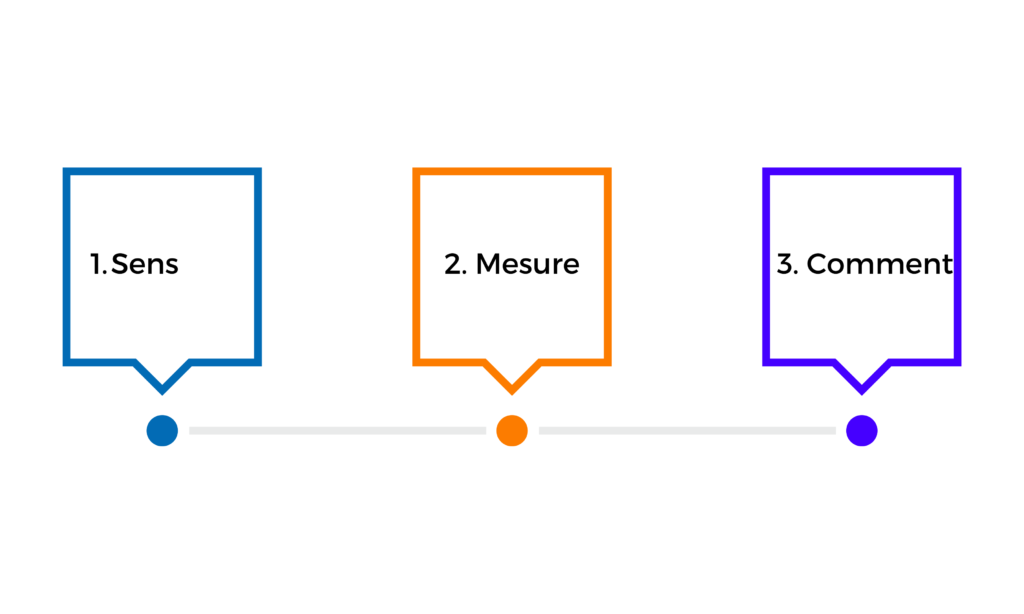How to lead to put into action … in the right direction?
Isn’t it satisfying to feel that we are moving in the right direction and at the right pace? Performance monitoring is also about creating and sharing alignment in the form of goals. How to do it? That’s what you’ll find here.
This article is part of a series of 3 video articles that aims to help you improve the monitoring of team performance. The 3 key principles of this series:
- The coaching staff motivates.
- Alignment puts into action.
- Clarity creates trust.
In this second part:
- Create goals that align with the organization’s vision.
- Drive action by creating clarity and engagement.
- Establish a concrete work plan with the involvement of participants in the achievement of the objectives.
How can we be in action in the right direction? Leading to action depends on two elements:
- Create goals that are aligned with your vision.
- Convey objectives in order to encourage action.
Therefore, how do you create goals that are aligned with the organization’s vision and how do you convey them to teams?
1. Lead to put into action by creating goals that are aligned with your vision
First, to put people into action, there needs to be a clear alignment. Thus, this clarity and alignment allows for an essential understanding: what are the goals connected to? In other words, why do we do this or another.
Your organization has a vision. That ultimate goal that you want to achieve within a set period of time (e.g. 1 to 3 years or 3 to 5 years. And every year, every quarter, or every month, and even every week, it is hoped that you will get closer to this ultimate goal.
Generally, to facilitate and clarify what to do, we set annual goals. Above all, we want to deliver these annual objectives while being supported by the team!
Here is a model. Adjust it to your context.
Currently, does it work for you to have annual goals? Or are you better per quarter? per month? Regardless of the deadline, there are no issues, because the frequency of revision and the deadlines related to your objectives must be the right ones for you.
What is really important is the alignment:
• First, what is your vision?
• Then, what is the next step to plan, in what timeframe, in order to get closer to your vision?
• Finally, how are you going to organize it?
Are your goals aligned with your vision?
The next step is to convey them clearly.
Example: You are a leader. You see a problem and you know the direction you want to take. Naturally, you probably have solutions in mind. So, if you’re like most leaders, you may give your solution as a goal to your team, is that normal?
For example, you want to optimize the XYZ process.
For good reason, your analysis of the situation shows that by optimizing this process, you will take a step forward towards your vision.
2. Convey objectives to encourage action
First, fostering action is done by creating clarity and engagement.
Here is a 3-step tool to create more meaning and enable action-oriented communication.
First, we will go in search of meaning, and secondly, we will look at how to measure the success of this objective. Thirdly, we will see how to achieve this in practice.
Step #1 to lead to put into action: The search for meaning
First, ask yourself: What will the purpose be used for?
Optimizing the XYZ process will serve to create an ABC customer experience.
Now, let’s continue to clarify the meaning by using an exercise called the “5 whys.”
Why #1: Once you get the ABC customer experience, what is it going to give you, allow you?
It will give me better testimonies.
Why #2: Once you have better testimonials, what will it give you?
It will give me a better reputation.
That way, we could continue up to 5. For the purposes of the example, we stop here.
In other words, the why behind your goals allows for alignment and explanation to your engaging teams that has a positive impact on motivation.
To go further, take the online (and independent) training: Adopt new ways of doing things to manage motivation and performance in today’s world.
Step #2 to Lead to Action: Measuring the Goal
And then ask yourself: How will you know at the end of the year that you’ve reached the goal?
In our example: the goal is to have a better reputation. How will I know at the end of the year that my organization is going to have a better reputation?
- an average of 4.5/5 on the reviews I receive on the internet;
- 75% of customers who return;
- 50% of new customers based on referrals.
We have our indicators and we will know what to measure and what to monitor during the year.
Step #3 to lead to action: Identifying the “how” through a participatory approach
Finally, ask yourself: How are we going to get a better reputation and see an average of 4.5/5 on our internet reviews, then 75% of returning customers and 50% of new customers referred?
To answer the “how”, I invite you to brainstorm with your team in which you will share the why, the indicators and ask them “how” are we going to get there.
Leave your meeting with a plan and steps to follow. Make sure your plan is realistic and plan it all in your calendars.
There is nothing more concrete than having time set aside to achieve your vision and goals!
Thus, this participatory approach promotes specific and measurable objectives AND team engagement and motivation.
To go further, take the online training (and in complete autonomy): Develop your courage to say, make decisions and delegate in order to lead to put into action.
Conclusion
In conclusion, to put people into action, you need meaning, alignment, indicators and an approach that involves those who will participate in achieving the goals
Take action by doing the following:
- First, review or create a goal and ask yourself why you want that particular goal.
- Then, see how you’re going to measure that goal.
- Finally, see how you can do this while sharing with your team.
- Don’t forget your work plan, concrete enough to move forward with motivation!
It is not always easy for a leader to lead by facilitating action and staying connected to himself, his team, and to the results! If you need professional and effective support, individual coaching can help you!
Leave me in the comments what your goal is, if you have any challenges or questions.






